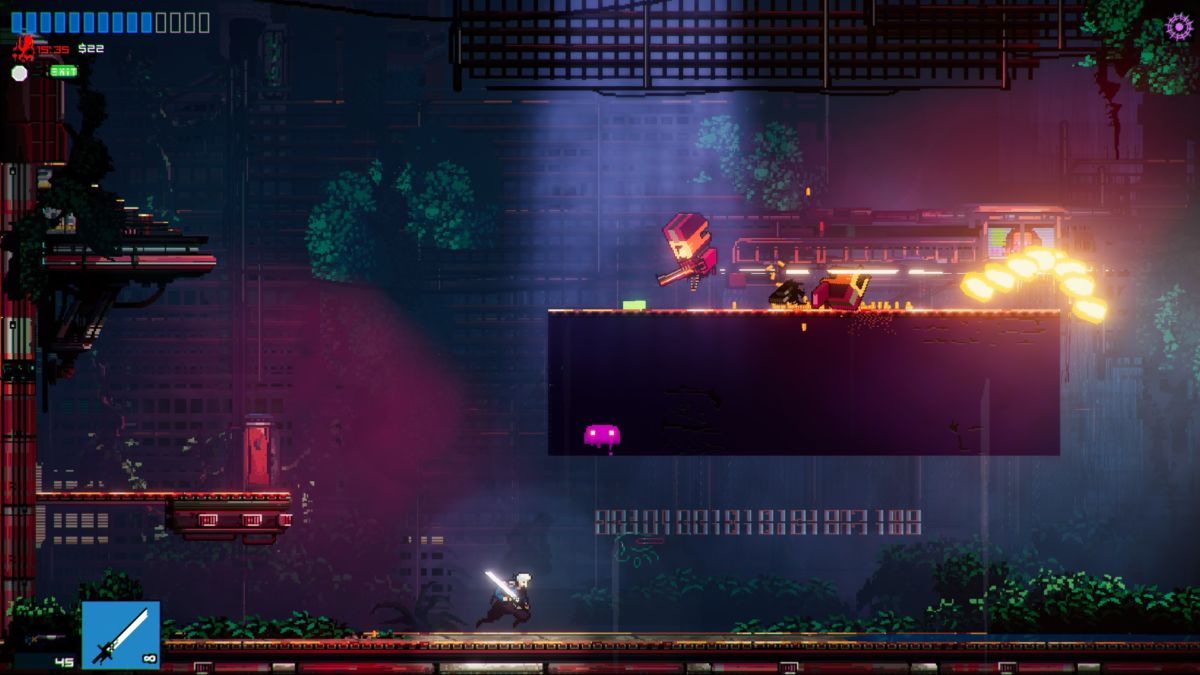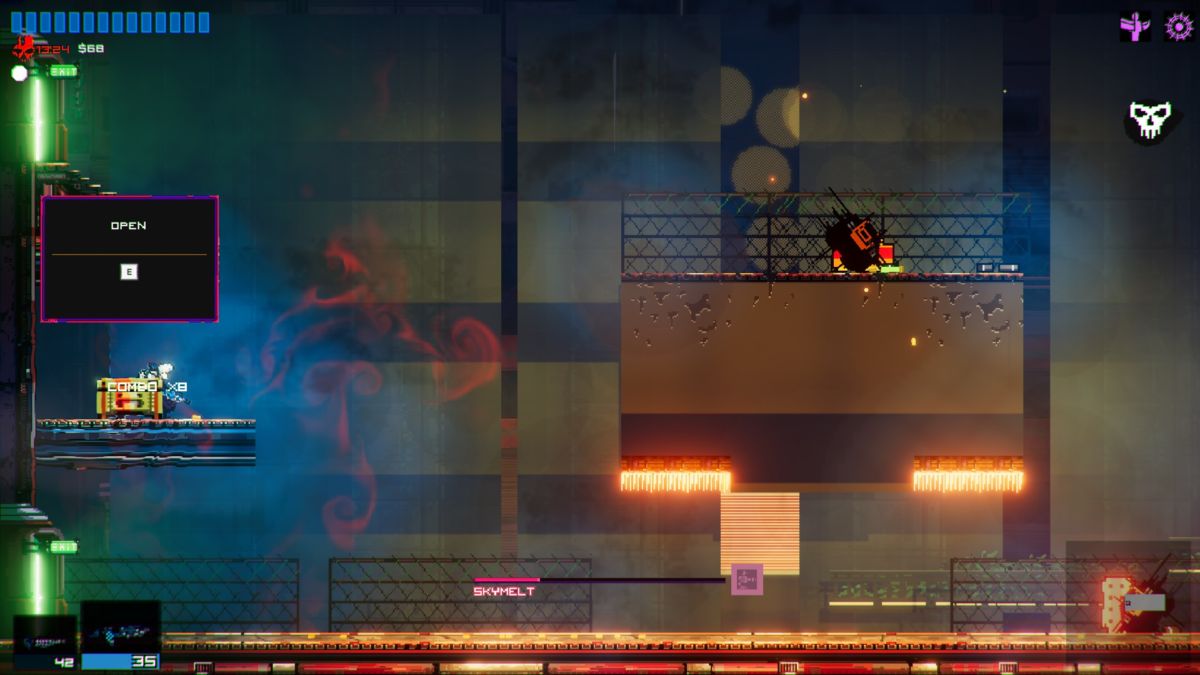Black Future ‘88 takes place in a dark cyberpunk world where it’s been 1988 since the bombs fell, turning the sky dark and the world neon. After a decade full of roguelikes, pixel graphics, and 80s nostalgia in general, I was a bit concerned that Black Future ‘88 might have been just a tad too late and feel trite at this point. However, as soon as the last notes of the intro sequence faded away, I knew they had me.
The first thing that will hit you when you start Black Future ‘88 is the music as it is the real star in this package. The bass is heavy and hard, and the synth is raw in a way I haven’t encountered since I saw the movie Mandy last year. It is a quintessentially cyber and angry sound that fits the dark cyberpunk aesthetics perfectly. Not only is the music good enough for me to want to order the soundtrack right this instance, but the limited voice work is also the chef’s kiss that seals the deal.
The tower is run by a rogue AI that is constantly evolving and adapting by eating the weapons and resources that you leave behind. Once in a while, the AI will make taunts and quips at you, and they are just superb. The voice has been made to sound like the demonic space station from the old arcade game Sinistar or the voice of The Black Knight cabinet, which is great. It is a brilliant and subtle reference that gave me the broadest grin while murdering my way through the tower.
For me, there’s a distinct coating of 80s and early 90s anime over Black Future ‘88. There are elements of Bubblegum Crisis, Akira, Cyborg 009 and AD Police all over this. From the rain-soaked backdrops to the neon flooded fights, it lives and breathes dystopian cyberpunk anime. This really helps it stand apart from all the other indie roguelikes that seem to pop up every other day. It also happens to appeal greatly to me as those were the shows and the aesthetics I grew up with in the early 90s
In Black Future ‘88, you play as one of several unlockable characters that must jump, shoot, stab and dash their way through an ever-evolving tower. They each come with two weapons and some sort of quirk to their play style. The overall goal of the game is to reach the pinnacle of the tower and defeat the big baddie Duncan, who not only built the damned thing but also caused the world to end. It plays similar to Dead Cells in that it is a fast-paced platformer with loads of weapons and gadgets strewn around the levels for you to use on your enemies.
Unlike Dead Cells though, Black Future ‘88 is mostly about projectile weapons and has a combat style that is more reminiscent of a twin-stick shooter. This makes encounters far more vertical in nature, making you dash and jump around enemies while adjusting your aim to deal death both above and below you. To help you mete out this death and destruction you have a large selection of weapons at your disposal. There are shotguns, neon spewing laser rifles and laser swords to pick up an play around with. While some are your basic projectiles and lasers, others come with more esoteric features. Features such as an assault rifle that makes you teleport when you fire at enemies or the machine gun that fires money- expensive but deadly. The teleport rifle, together with a perk that makes you shoot out laser spikes when hit, was an especially potent and chaotic combination in my playthroughs.
Yes, in addition to weapons, you also gain access to some cool perks and buffs. Aside from the aforementioned spike perk, there are upgrades where your dash moves through solid objects or hurt the enemies that you pass through. There are also some cursed perks you can pick up that will come with some penalties, as well as better benefits. Although it is hard to say for certain at this point, it stands to be a highly flexible and varied combat system when it is all put together.
To add another wrinkle to the challenge ahead, you have a hard time limit of 18 minutes before your heart explodes. This countdown to death serves two purposes: it pushes you along at a high pace and it becomes a sort of risk/reward system. Throughout the level, you can find stations which grant you perks and buffs. However, these stations often require a sacrifice of time. Want full health and shields? That will be three minutes, please. I can easily see this leading to some nail-biting decisions, especially in the late game about whether time or strength is preferred for the upcoming battle.
Normally, I am not the type of player who enjoys such timers. I tend to want to explore and soak in areas before moving on. It is, therefore, such a relief to see that the timer, while exerting a certain amount of pressure, is still quite reasonable. I felt I was able to at least do a bit of exploring before moving on to the next area. Naturally, it is hard to judge this completely until we have access to the whole game and can get a better understanding of how much time is needed, but for now, it feels well balanced. Challenging, but not excruciatingly punishing.
Black Future ‘88’s visuals typically ‘indie pixel’ in a way that might make some groan after a decade or so with titles in this style. However, Black Future ‘88 smartly sidesteps this trap by laying on a spectacular layer of effects that has me wondering if there aren’t some 3D models lurking in the graphics somewhere. Levels are soon filled with smoke and neon colored lasers and flashy explosions that light up the environment and make the whole thing come alive in a way that is hard with just faux SNES graphics. It is hard to see in screenshots but in motion, it looks amazing.
Though my limited time with Black Future ‘88 has been a real blast so far, there are some question marks remaining. Being a roguelike means you will make numerous runs through the game before you reach the endpoint. As such, it is highly reliant upon being able to constantly give you new toys, enemies and mysteries to play around with. At this point, it is hard to say whether or not Black Future ‘88 will have enough of this to sustain itself in the long run. Again, I really liked what I saw and played but it is something we won’t know for sure until the whole game is available.
Another hallmark of these types of games is the difficulty. Despite being completely new to the game and its mechanics, I managed to run through three areas and reach the end point of the demo on my second try. It is not that there is little challenge to the game, there is actually plenty, but in many other games of this ilk you are afforded one, maybe two mistakes before it is time for the dirt nap. In Dark Future ‘88 you can mess up quite a lot without screwing yourself over. This might be cause for both joy and concern for some people.
The abrasiveness of the genre pushes a lot of people away, making them miss out on some real gems in terms of design, art and atmosphere. On the other hand, difficulty is such an essential part of these games that you wonder if they can work at all without this element. It might very well be that my decisions and failures in the early parts of the tower would have completely wrecked me had the game continued. It is not unheard of, either — Darkest Dungeon’s difficulty develops like a hockey stick diagram and the last level of the game is almost impossibly hard to beat.
Hopefully, these small blemishes are things that will get adjusted prior to its release. If what I played of the preview is indicative of the final product, I am ready for it to be 1988 and rain for eternity.
Preview code supplied by PR
Some of the coverage you find on Cultured Vultures contains affiliate links, which provide us with small commissions based on purchases made from visiting our site. We cover gaming news, movie reviews, wrestling and much more.







